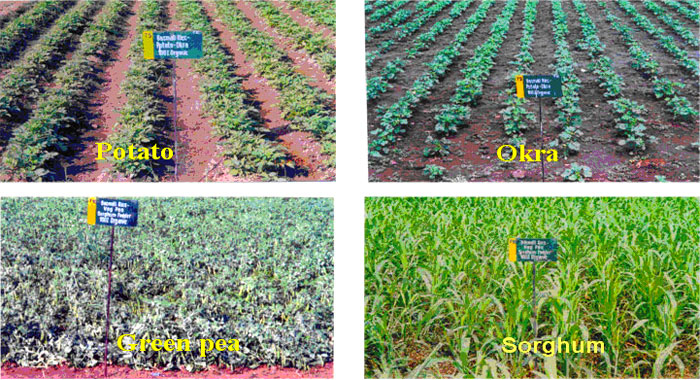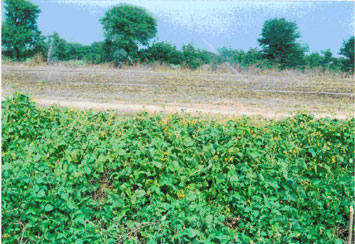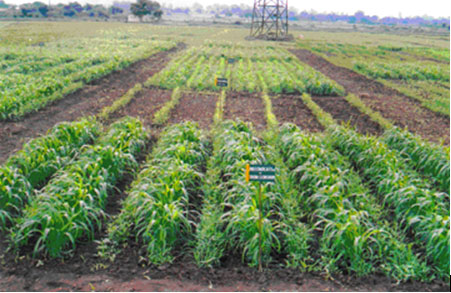|
S.No
|
Name of the project
|
Period
|
Centres
|
|
A. Research projects funded by the State Government
|
|
1
|
Agricultural Research Laboratory & Institute (N P)
|
1964*
|
Jabalpur, Rewa, Gwalior, Indore
|
|
2
|
M.P. Agricultural Research Institute (N P)
|
1964*
|
Jabalpur
|
|
3
|
Fodder Research Scheme (S P)
|
1964*
|
Jabalpur
|
|
4
|
Sugarcane Research (S P)
|
1964*
|
Sehore (upto 2001), Baghai, Joara & Powarkheda (w.e.f. 2002)
|
|
5
|
Cotton Research (S P)
|
1964*
|
Badnawar (upto 2000), Khandwa
|
|
B. Research projects funded by ICAR/PL-480
|
|
1
|
AICRP on Cropping Systems
|
1964*
|
Jabalpur, Rewa, Indore, Sehore(1980 – 2004), Gwalior (upto 1984), Raipur (upto 1986),Powarkheda (upto 1980 and after 2005), ECF centers running in all districts of thestate
|
|
2
|
AICRP on Water Management
|
1968-80, 1980*,
1986*
|
Jabalpur for tube well command area.
Powarkheda for canal command area
Morena for canal command area
|
|
3
|
AICRP on Dryland Agriculture
|
1969*
|
Indore, Rewa
|
|
4
|
AICRP on Forage Crops
|
1970
|
Jabalpur
|
|
5
|
AICRP on Weed Management
|
1978-83, 84-2000,
2001*
|
Jabalpur under (PL-480) ,Gwalior
|
|
6
|
6. Network Project on Organic Farming Research
|
2003
|
Jabalpur
|
|
7
|
AICRP on Crop Improvement on almost all crops at all Research Stations of the University
( nearly 20 in numbers)
|
Current Significant Research Highlights - Cropping Systems
Rice based cropping systems
Diversification of cropping system from existing rice-wheat or rice-chickpea system
to hybrid rice-marigold-maize system produced higher rice equivalent yield (23.46
t/ha/year) with higher net monetary returns (NMR) of Rs 98052/ha/year, system productivity
(71.43 kg/ha/day) and water use efficiency (185 kg/ha/cm). The next best intensified
cropping system was hybrid rice-onion-green gram with these regards. These cropping
systems were quite feasible without jeopardizing the sustainability of productivity
in rice-wheat cropping system under irrigated production system of Kymore Plateau
and Satpura hills zone of Madhya Pradesh.
Soybean based cropping system
Soybean-sugarcane+garlic system led to register maximum soybean equivalent yield
(SEY) of 15.93 t/ha/year and NMR of Rs 123208/ha/year followed by soybean-potato-sesame
with SEY of 9.87 t/ha/year and NMR of Rs 84404/ha/year. These cropping systems were
more remunerative and efficient than existing soybean-wheat/chickpea system under
irrigated eco-system in Central Narmada Valley Zone.
Soybean-onion cropping system led to record maximum SEY (14.17 t/ha/year) and NMR
(Rs 139232/ha/year) in Malwa Plateau Zone of Madhya Pradesh followed by soybean+maize
(4:2 rows)-potato system with SEY of 8.5 t/ha/year and NMR of Rs 87386/ha/year.
These cropping systems were superior over prevailing soybean-wheat cropping system
in the zone.
Nutrient Management
Based on the results of a long term study for 22 years (1985-2007) on integrated
nutrient management (INM) in rice-wheat cropping system at Jabalpur, application
of 50% NPK through fertilizers+50% N through green leaf manuring/FYM/wheat bhusa
to rice followed by 100% NPK through fertilizers to wheat as well as 75% NPK through
fertilizer+25% N through green leaf manuring/FYM/wheat bhusa to rice and 100% NPK
through fertilizers to wheat proved superior over application of 100% NPK through
fertilizers to both crops with regard to total system productivity as wheat equivalent
yield (WEY) besides improvement in soil properties. Thus, there was a saving of
25 to 50% NPK fertilizers with the integrated use of organic manures without sacrificing
the productivity and profit. Among the organic sources, green leaf manuring of sunhemp
proved better than FYM and wheat bhusa with regard to productivity, monetary advantages
and sustainability index.
While evaluating the long-term effect of continuous cropping and fertilizer application
in rice-wheat cropping system over 30 years at Rewa, the WEY (8.26 t/ha/year) and
NMR (Rs 43528/ha/year) were maximum with the application of 120 kg N+80 kg P2O5
+ 40 kg K2O/ha to both crops. Though the productivity of individual crop component
or cropping system as a whole was maximum with the continuous application of recommended
dose of fertilizers, the yield levels showed declining trend after 10 years due
to the development of S and Zn deficiencies. The trend of reduction in response
of crops to N, P and K was more prominent with imbalance supply of these nutrients
through fertilizers.
While studying the site specific nutrient management in rice-wheat cropping system
at Jabalpur, application of nutrients based on soil test values as 150 kg N+100
kg P2O5 + 60 kg K2O+ 10 kg S+5 kg Zn+1.5 kg B+0.5 kg Mo/ha to both crops produced
maximum grain yields of rice (5.95 t/ha), wheat (4.74 t/ha) and entire cropping
system as WEY (8.83 t/ha/year) which were comparable to those obtained with the
application of recommended fertilizer dose (120 kg N+60 kg P2O5 + 40 kg K2O) along
with 10 t FYM/ha to both crops. The yields of both crops drastically reduced by
reducing the doses of P and K or missing of S and Zn application.
Resource Conservation Technology
Direct drilling of seeds in dry fields or seeding of sprouted seeds by drum seeder
or transplanting of seedlings by self propelled transplanter gave almost comparable
rice yields which were more economical than those of rice yields obtain by manual
transplanting. Strip till sown succeeding wheat gave significantly higher yields
than conventional till sown or zero till sown wheat which were at par. Thus, direct
seeded rice or mechanically transplanted rice followed by strip till sown wheat
was the best package of tillage and sowing methods of both crops under rice-wheat
system with regard to higher productivity, profit and benefit cost ratio besides
improving soil properties and saving of time, labour and diesel etc.
System of Rice Intensification (SRI)
The SRI produced 25 to 30% higher grain yield than conventional and direct seeding
methods. Following practices of SRI have been identified at Jabalpur and suitable
for Madhya Pradesh:
- Well leveled field with proper drainage facility is suitable.
- Transplanting of 14-day old seedlings with one seedling/hill is good.
- Square planting geometry of 25cmX25cm is optimum.
- Carefully uprooted seedlings intact with seed without much jerk should be used for
transplanting immediately.
- The field should be kept moist avoiding standing water during growing period with
a dry conditions for 2-3 days at the interval of 10 days.
- Mechanical weed control by using rice rotary weeder at 10 days interval starting
from 10 DAT for proper aeration.
- Application of 10 t FYM/ha along with 80 kg N+50 kg P2O5+30
kg K2O/ha is adequate to realize the potential yields. Full quantity
of FYM, phosphorus and potash should be applied at the time of final seed bed preparation
and nitrogen should be applied in 3 splits as 40,20and 20kgN/ha at 7,25 and 55 DAT,
respectively.
Organic farming
Rice (Pusa basmati)-potato(K. sinduri) – okra (Parbhani kranti),rice-vegetable pea(Arkel)-sorghum(Pusa
chari) and green manuring-rice (Pusa basmati)-berseem (fodder and seeds) systems
were quite feasible and economically sound rice based organic farming systems under
assured irrigation throughout the year. But rice –potato system was promising with
the availability of irrigation up to month of March only. Yields of vegetable pea,
okra, berseem and sorghum (fodder) under organic nutrient management were comparable
to those obtained with inorganic nutrient management ,but yields of rice and potato
were lesser with organic nutrition during the beginning 3 years than inorganic nutrition.
Green manuring before rice and intercropping of Isabgol with potato compensated
the losses of yields in rice and potato under organic nutrient management.
Rice-potato –okra system produced maximum yields (17.8 t/ha/year) in terms of rice
equivalent yield, (REY) with the net monetary return (NMR) of Rs. 1, 57,658/ha/yr
under organic farming. Rice berseem (seed and fodder) and rice-vegetable pea-sorghum
(fodder) systems were next to former with regards to REY and NMR.
Green manuring of sunhemp before rice reduced weed intensity by nearly 50% besides
curtailing 25% of the recommended fertilizer. Positive effect of organic nutrient
management on improvement of organic carbon contents and microbial population in
soil was remarkable.
Maize + marigold – potato + tomato – onion + tomato systems proved promising organic
farming system with the productivity of 33.6 t/ha/year in terms of potato equivalent
yield and NMR of Rs. 1,50,600/ha/yr for Malwa region of the state. Soybean-durum
wheat system produced maximum yield of 5.46 t/ha as wheat equivalent yield with
NMR of Rs.36580/ha for Central valley region of the state.
Weed Management

Rice
Pre emergence application of Anilofos 0.45 kg/ha appreciably curbed the growth of
Echinochloa colona (a most serious weed) and proved equally good to the application
of Butachlor 1.5 kg/ha for controlling the weeds in both direct seeded and transplanted
rice. Post emergence application of Fenoxaprop –p-ethyl 100 g/ha at 25 days after
sowing or transplanting (DAS/DAT) controlled the grassy weeds to the maximum extent
and proved as good as two hand weedings done at 20 and 40 DAS/DAT. Sequential application
of Fenoxaprop-p-ethyl 100 g/ha at 25 DAS/DAT and 2, 4-D EE 0.5 kg /ha at 30 DAS/DAT
was found most effective for controlling both grassy and broad leaved weeds. Early
post emergence application (at 10 DAT) of phenoxsulam 20 g/ha was found quite efficient
to control grassy weeds in transplanted rice.
Green manuring of 60 to 75 days old Sesbania reduced the weed intensity in
the tune of 45 to 56 % in transplanted rice.
Wheat
Post emergence application of Isoproturon 1.0 kg/ha at 25 DAS controlled the infestation
of Phalaris minor (a most serious weed), but Fenoxaprop-p-ethyl 75 g/ha gave
an excellent control of Phalaris minor and Avena fatua. Similarly,
post emergence application of Sulfosulfuron 25 g/ha or Isoguard 1.0 kg/ha or Clodinofop
60 g/ha were found promising herbicides for controlling weeds in wheat. Combined
application of Clodinofop 60 g and Metribuzin 150 g /ha as post emergence at 20
DAS found most efficient in controlling almost all grassy and broad leaved weeds.
Oilseed crops
Pre emergence application of Metribuzin 0.5 kg/ha followed by one hand weeding at
30 DAS controlled the weeds most effectively in soybean. Early post emergence application
of Imazethapyr 0.75 kg/ha at 15 DAS followed by one hand hoeing at 30 DAS produced
30 % higher seed yield of soybean over application of Imazethapyr alone.
Pre emergence application of Oxydiargyl 100 g or Alachlor 1.5 kg/ha effectively
controlled the weeds in irrigated mustards. The pre emergence application of Alachlor
1.5 kg/ha coupled with one hand hoeing at 30 DAS was quite effective in controlling
weeds associated with sesame and niger crops.
Non cropped lands
Application of Glyphosate 2.0 kg/ha or Combi (mixture of Glyphosate 35 % + 2,4-D
35 %) 2.0 kg/ha during August month effectively controlled the kharif annuals
within the period of 2 weeks and the perennials weeds viz. Saccharum spontaneum
as well as Cynodon dactylon within the period of 4 weeks. But application
of Glyphosate or Combi at higher rates (2.5 to 3.0 kg/ha) controlled the perennials
weeds within 15 days.
Development of promising oat genotype
A new oat genotype JO2000-61 has been developed from the cross between Kent X UPO
130, which out yielded among all genotypes consecutively during past 4 years under
all India coordinated trials. It produced green fodder yield of 600-625 q/ha, along
with seed yield of 17-19 q/ha within a period of 100-110 days in all fodder research
centres of central zone. Thus, it has been recommended for consideration to central
variety release committee in the national group meet of forage crops. It has been
already released by state variety release committee for cultivation in Madhya Pradesh.
Rice bean identified as a new lean period fodder

Rice bean (Vigna umbellate) has been introduced as a nutritious legume fodder crop
for cultivation under low as well as high rainfall situation in rainfed production
systems of Madhya Pradesh. It has superiority over other leguminous fodder crops
due to its fast and indeterminate growth habit, high yielding ability and tolerance
to high and low moisture stress. Thus, it has ability to sustain during lean period
for green fodder supply. An improved genotype-JRBJ 05-1 has been developed on this
crop which have been included in all India coordinated trials.
Fodder based cropping system under rainfed condition

Intercropping of pigeon pea cv. Asha+forage sorghum cv. Pusa Chari in 1:2 row proportion
at 25 cm apart produced green fodder yield of 537 q/ha along with 12.7 q/ha seed
yield of pigeon pea under rainfed production system.